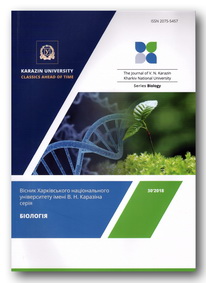Dirhenium(III) complex with beta-alanine ligand: anticancer, antioxidant and DNA-binding properties
Abstract
Earlier we have shown that dirhenium(III) dicarboxylate complex with γ-aminobutyric acid possessed higher antitumor activity, than those of the previously investigated alkylcarboxylates, also may act as a modulator of cisplatin mechanism of action and as a stabilizer of red blood cells in tumor-bearing organisms. Thus, the task of the work was to investigate anticancer activity of the complex cis-[Re2(β-Ala)2Cl6] (I) in the model of tumor growth in vivo and to realize if the amino acid residue influences the DNA-binding activity of the amino acid derivatives of the cluster rhenium(III) compounds. Antitumor properties of the complex I were studied in the model of tumor growth with the use of Wistar rats inoculated by tumor carcinoma Guerink cells. The introduction of the compound alone in free and liposomal forms inhibited the tumor growth by 36 % and 45 % correspondingly, that is more than for dirhenium(III) clusters with alkyl ligands. The combined introduction of I and cisplatin had a significant impact on the tumor growth and showed the disappearance of the tumors in most of the animals. No considerable differences were found between introduction of liposomal and free form of I. The electronic absorption spectra of Calf Thymus DNA (CT-DNA) exhibit hyperchromism in the presence of increasing amounts of I. The DNA band at ~ 260 nm arises from the π-π* transitions of the nucleic acid bases and changes in the intensity and slight wavelength shifts of this characteristic band reflect the corresponding structural modifications of the DNA, which include changes in stacking, disruption of the hydrogen bonds between complementary strands, covalent binding of the DNA bases, intercalation of aromatic rings and others. The binding constant Kb(I) = 2.43 × 103 M-1 to CT-DNA was obtained that was lower than the values reported for the classical DNA intercalators and compares well with the magnitude of the binding constants for other complexes of dirhenium(III); titration of СT-DNA with cisPt and hydrogen peroxide also leads to a hypochromic effect, weak at low concentrations and more significant at high concentrations of I; the DNA binding constants increased in several times when using H2O2 or cisplatin that confirms a mechanism for redox activation of interaction of I with DNA in a cancer cell. The obtained results demonstrate the possibility of application of the amino acid derivatives of dirhenium(III) clusters in antitumor therapy.
Downloads
References
Cotton F.A., Walton R.A. (2005). Multiple bonds between metal atoms. 3rd ed. Springer Science and Business Media. 818 p. https://doi.org/10.1021/ja0697267
Golichenko A.A., Shtemenko A.V. (2006). Cluster rhenium(III) complexes with adamantanecarboxylic acids: synthesis and properties. Rus. J. of Coord. Chem., 32, 242–249. https://doi.org/10.1134/S1070328406040038
Golichenko A.A., Domasevitch K.V., Kytova D.E., Shtemenko A.V. (2015). Crystal structure of cis-bis(μ-β-alanine-κ2O:O')bis[trichloridorhenium(III)](Re–Re) sesquihydrate. Acta Cryst., E71, 45–47. https://doi.org/10.1107/s2056989014026620.
Ismail M.B., Booysen I.N., Akerman M.P. (2019). DNA interaction studies of rhenium compounds with Schiff base chelates encompassing biologically relevant moieties. Nucleosides, Nucleotides and Nucleic Acids, 38(12), 950–971. https://doi.org/10.1080/15257770.2019.1639058.
Leus I.V., Shamelashvili K.L., Skorik O.D. et al. (2012). Antioxidant and antitumor activity of dirhenium dicarboxylates in animals with Guerin carcinoma. Ukr. Biokhim. Zh., 84(3), 87–96. (In Ukrainian)
Li Z., Shtemenko N., Yegorova D. et al. (2015). Liposomes loaded with a dirhenium compound and cisplatin: preparation, properties and improved in vivo anticancer activity. J. of Liposome Res., 25(1), 78–87. https://doi.org/10.3109/08982104.2014.954127
Martınez-Lillo J., Mastropietro T.F., Lappano R. et al. (2011). Rhenium(IV) compounds inducing apoptosis in cancer cells. Chem. Comm., 47, 5283–5285. https://doi.org/10.1039/C1CC11038A
Majer Z., Bosze S., Szabo I. et al. (2015). Study of dinuclear Rh(II) complexes of phenylalanine derivatives as potential anticancer agents by using X-ray fluorescence and X-ray absorption. Microchemical Journal, 120, 51–57. https://doi.org/10.1016/j.microc.2015.01.002
Paramonova K., Golichenko A., Babiy S. et al. (2016). The interaction of DNA with cluster rhenium compounds of different structural types. World of Med. and Biol., 56(2), 140–144.
Polokhina K., Golichenko A., Babiy S. et al. (2016). Investigation of the interaction of cluster compounds of rhenium with biological active ligands with supercoiled DNA by electronic spectroscopy. Visnyk of Lviv University, Biol. series, 72, 15–24.
Polokhina K.V., Kytova D.E., Shtemenko A.V., Shtemenko N.I. (2020). Antiproliferative activity of the cluster rhenium compound with β-alanine ligands. Ukr. Biochem. J., 92(1), 120–126. https://doi.org/10.15407/ubj92.01.120
Shtemenko N., Collery P., Shtemenko A. (2007). Dichlorotetra-μ-isobutyratodirhenium(III): enhancement of cisplatin action and RBC-stabilizing properties. Anticancer Res., 27(4B), 2487–2492.
Shtemenko A.V., Collery P., Shtemenko N.I. et al. (2009). Synthesis, characterization, in vivo antitumor properties of the cluster rhenium compound with GABA ligands and its synergism with cisplatin. J. Chem. Soc., Dalton Trans., 26, 5132–5136. https://doi.org/10.1039/b821041a
Shtemenko N.I., Chifotides H.T., Domasevitch K.V. et al. (2013). Synthesis, X-ray structure, interactions with DNA, remarkable in vivo tumor growth suppression and nephroprotective activity of cis-tetrachloro-dipivalato dirhenium(III). J. of Inorg. Biochem., 129, 127–134. https://doi.org/10.1016/j.jinorgbio.2013.09.001
Shtemenko A.V., Chifotides H.T., Yegorova D.E. et al. (2015). Synthesis and X-ray crystal structure of the dirhenium complex Re2(i-C3H7CO2)4Cl2 and its interactions with the DNA purine nucleobases. J. of Inorg. Biochem., 153, 114–120. doi:10.1016/j.jinorgbio.2015.06.012
Shtemenko A.V., Shtemenko N.I. (2017). Rhenium–platinum antitumor systems. Ukr. Biochem. J., 89(2), 5–30. https://doi.org/10.15407/ubj89.02.005
Zhang P., Sadler P.J. (2017). Redox-active metal complexes for anticancer therapy. Eur. J. Inorg. Chem., 2017(12), 1541–1548. https://doi.org/10.1002/ejic.201600908
Authors retain copyright of their work and grant the journal the right of its first publication under the terms of the Creative Commons Attribution License 4.0 International (CC BY 4.0), that allows others to share the work with an acknowledgement of the work's authorship.




